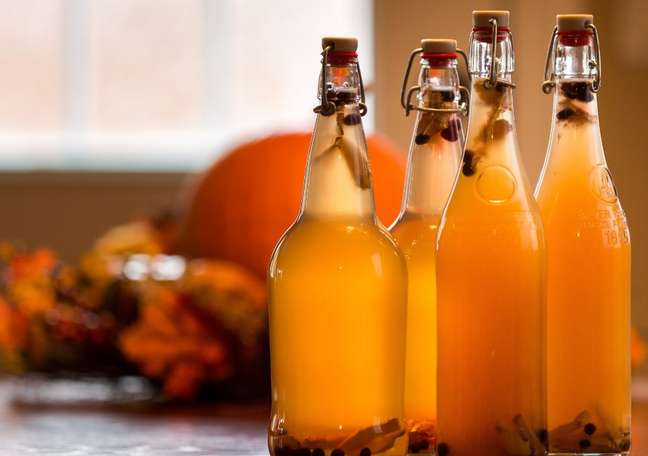
Kombucha is a tea drink with caffeine and sugar. But, after all, what makes this tea so special and famous among the crowd? In it, fermentation takes place by a colony of bacteria and yeasts called SCOBY and, thanks to fermentation, tea becomes a fizzy drink that brings a large amount of probiotics, which are good for your health!
Now that you know the basics, a few things still need to be simple: What are probiotics? Why is kombucha so good for health? Can I do it at home? Check out all the answers with the help of the Cooking Guide!
What are the benefits of kombucha?
Kombucha is rich in probiotics, which, in turn, are products of fermentation. It is probiotics that make the good bacteria present in the intestines proliferate more and delay the development of bad bacteria. In other words, probiotics are responsible for establish a balance for the microbiota of the intestine and, consequently, its proper functioning!

The impact of kombucha on diet
Despite being a recipe of Chinese origin with more than 2000 years of tradition, there are still few studies to support the impact of kombucha consumption on the health of the body. According to nutritionist and gastronomist Laura Franco, there are reports that the probiotics offered by tea would lead to improvements in diabetes, cardiovascular disease and even intestinal disease, but it is not yet possible to say for sure.
The tea specialist and founder of Experiências do Chá, Ju Fuscaldo, guarantees that kombucha strengthens the immune system, fights premature aging and improves the absorption of nutrients by the body. Furthermore, tea would also be an excellent energy stimulant, thanks to the presence of caffeine in its composition.
How often should I drink tea?
To ensure the benefits offered by tea, kombucha consumption should occur 3 to 5 times a week. By the way, due to the energy boost of the drink, it is interesting that it is enjoyed immediately for breakfast.
On the other hand, some precautions are necessary. In the case of pregnant women, kombucha should be avoided, due to the levels of caffeine in the drink and the few studies performed on the activity of probiotics in the body.
kombucha recipe

Time: 40 minutes (+1 week off)
Performance: 10 portions
Difficulty: average
Ingredients:
- SCOBY culture
- 1.6 liters of filtered water
- 15 g of tea with caffeine*
- 1/2 cup demerara sugar or granulated sugar to taste
- 100 ml of the last fermentation liquid (or 1/2 cup of apple cider vinegar)
*As for the herb chosen, mate tea is a good option. If you prefer, you can use 10 g of caffeine-free tea combined with 5 g of another herb that contains caffeine. For example, 10 g of mate tea and 5 g of hibiscus.
Where to find SCOBY?
The community of people who brew kombucha often donate cultures as they multiply. This way, you just have to search among acquaintances or even in social network groups, where SCOBY donations and sales take place!
Method of preparation
first fermentation
At first, boil 1 liter of water. Then, turn off the heat, add 15 g of herbal tea of your choice and leave for 10-15 minutes. Then strain and discard the herbs. Add another 600 mL of filtered water and allow to cool to room temperature. By the way, be careful: this step is very important, because very high temperatures can kill the SCOBY
Then add 1/2 cup of sugar and mix well. Add the SCOBY culture to your mixture in a glass bottle and also add 100ml of the last fermentation liquid. This liquid is normally present in the acquired culture, but if it is not present, just add 1/2 cup of apple cider vinegar.
Finally, just cover it with a voile or a napkin that allows the tea to “breathe” and wait for the fermentation time between 7 and 10 days. Then, after a week, try the kombucha and decide whether to wait any longer, according to your personal taste.
Tip: The longer the fermentation time, the more acidic the mixture. Then freeze and enjoy.
second fermentation
The second brew is completely optional and is just for flavoring your tea! Next, transfer the kombucha to a plastic bottle, add 100ml of the top fermentation liquid (from the SCOBY) and whatever ingredient you want to use for flavouring! Then, wait for fermentation for 2 days or until the bottle has expanded and Consume within 7 days.
To flavor your tea with sugar-rich fruit like pineapple or berries, simply add chunks to the fermented tea. On the other hand, it is also possible to puree the fruit in a blender with a little tea and then add it all to the original blend. When using low-sugar leaves, roots, or fruits, add your chosen ingredient and 3 tablespoons of sugar to the original kombucha. For example, taste with mint, basil, ginger or lemon.
Income: Laura Franconutritionist and gastronome
🇧🇷The best content in your email for free. Choose your favorite Terra newsletter. Click here!
Source: Terra
Ben Stock is a lifestyle journalist and author at Gossipify. He writes about topics such as health, wellness, travel, food and home decor. He provides practical advice and inspiration to improve well-being, keeps readers up to date with latest lifestyle news and trends, known for his engaging writing style, in-depth analysis and unique perspectives.







